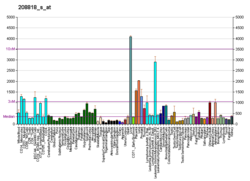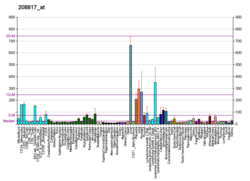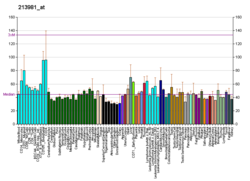Catechol-O-methyltransferase
| catechol-O-methyltransferase | |||||||||
|---|---|---|---|---|---|---|---|---|---|
| Identifiers | |||||||||
| EC no. | 2.1.1.6 | ||||||||
| CAS no. | 9012-25-3 | ||||||||
| Databases | |||||||||
| IntEnz | IntEnz view | ||||||||
| BRENDA | BRENDA entry | ||||||||
| ExPASy | NiceZyme view | ||||||||
| KEGG | KEGG entry | ||||||||
| MetaCyc | metabolic pathway | ||||||||
| PRIAM | profile | ||||||||
| PDBstructures | RCSB PDBPDBePDBsum | ||||||||
| Gene Ontology | AmiGO/QuickGO | ||||||||
| |||||||||

Catechol-O-methyltransferase(COMT;EC2.1.1.6) is one of severalenzymesthat degradecatecholamines(neurotransmitters such asdopamine,epinephrine,andnorepinephrine),catecholestrogens,and various drugs and substances having acatecholstructure.[7]In humans, catechol-O-methyltransferase protein is encoded by theCOMTgene.[8]Two isoforms of COMT are produced: the soluble short form (S-COMT) and the membrane bound long form (MB-COMT). As the regulation of catecholamines is impaired in a number of medical conditions, several pharmaceutical drugs target COMT to alter its activity and therefore the availability of catecholamines.[9]COMT was first discovered by thebiochemistJulius Axelrodin 1957.[10]
Function
[edit]Catechol-O-methyltransferase is involved in the inactivation of thecatecholamineneurotransmitters(dopamine,epinephrine,andnorepinephrine). The enzyme introduces amethylgroup to the catecholamine, which is donated byS-adenosyl methionine(SAM). Any compound having a catechol structure, like catecholestrogens and catechol-containing flavonoids, are substrates of COMT.
Levodopa,a precursor of catecholamines, is an important substrate of COMT. COMT inhibitors, likeentacapone,save levodopa from COMT and prolong the action of levodopa.[11]Entacapone is a widely used adjunct drug of levodopa therapy. When given with an inhibitor of dopa decarboxylase (carbidopa or benserazide), levodopa is optimally saved. This "triple therapy" is becoming a standard in the treatment ofParkinson's disease.
Specific reactions catalyzed by COMT include:
- L-DOPA(levodopa) →3-O-methyldopa
- Dopamine→3-methoxytyramine
- DOPAC→ HVA (homovanillic acid)
- Norepinephrine→normetanephrine
- Epinephrine→metanephrine
- Dihydroxyphenylethylene glycol(DOPEG) →methoxyhydroxyphenylglycol(MOPEG)
- 3,4-Dihydroxymandelic acid(DOMA) →vanillylmandelic acid(VMA)
In the brain, COMT-dependent dopamine degradation is of particular importance in brain regions with low expression of the presynapticdopamine transporter(DAT), such as theprefrontal cortex[12][13][14][15](In the PFC, dopamine is also removed by presynapticnorepinephrine transporters(NET) and degraded bymonoamine oxidase.).[16]Controversy exists about the predominance and orientation of membrane bound COMT in the CNS,[17][18][19]that is, whether this COMT process is active intracellularly in postsynaptic neurons and glia, or oriented outward on the membrane, acting extracellularly on synaptic and extrasynaptic dopamine.
Soluble COMT can also be found extracellularly, although extracellular COMT plays a less significant role in the CNS than it does peripherally.[20]: 210 Despite its importance in neurons, COMT is actually primarily expressed in the liver.[20]: 135
Genetics in humans
[edit]The COMT protein is coded by the geneCOMT.The gene is associated with allelic variants. The best-studied isVal158Met.[15] Others arers737865andrs165599that have been studied, e.g., for association withpersonality traits,[21]response toantidepressantmedications,[22]and psychosis risk associated withAlzheimer's disease.[23]COMT has been studied as a potential gene in the pathogenesis of schizophrenia; howevermeta-analysesfind no association between the risk of schizophrenia and a number of polymorphisms,[24]including Val158Met.[25][26][27]
Val158Met polymorphism
[edit]A functionalsingle-nucleotide polymorphism(a common normal variant) of the gene for catechol-O-methyltransferase results in avalinetomethioninemutation at position 158 (Val158Met)rs4680.[15]In vitro, thehomozygousVal variant metabolizes dopamine at up to four times the rate of its methionine counterpart.[22]However, in vivo the Met variant isoverexpressedin the brain,[28]resulting in a 40% decrease (rather than 75% decrease) in functional enzyme activity.[29]The lower rates of catabolism for the Met allele results in higher synaptic dopamine levels following neurotransmitter release, ultimately increasing dopaminergic stimulation of the postsynaptic neuron. Given the preferential role of COMT in prefrontal dopamine degradation, the Val158Met polymorphism is thought to exert its effects on cognition by modulating dopamine signaling in thefrontal lobes.
The gene variant has been shown to affectcognitivetasks broadly related toexecutive function,such as set shifting, response inhibition, abstract thought, and the acquisition of rules or task structure.[30][31][32]
Comparable effects on similar cognitive tasks, the frontal lobes, and the neurotransmitter dopamine have also all been linked toschizophrenia.[33][34]It has been proposed that an inherited variant ofCOMTis one of the genetic factors that may predispose someone to developing schizophrenia later in life.[35]A more recent study cast doubt on the proposed connection between this gene and any alleged casual effect of cannabis on schizophrenia development.[36]
A non-synonymoussingle-nucleotide polymorphismrs4680 was found to be associated with depressed factor ofPositive and Negative Syndrome Scale(PANSS) and efficiency of emotion inschizophreniasubjects.[37]It is increasingly recognised that allelic variation at the COMT gene are also relevant for emotional processing, as they seem to influence the interaction between prefrontal and limbic regions. Research conducted at theSection of Neurobiology of Psychosis,Institute of Psychiatry, King's College London has demonstrated an effect of COMT both in patients with bipolar disorder and in their relatives,[38]but these findings have not been replicated so far.
The COMT Val158Met polymorphism also has apleiotropiceffect on emotional processing.[38][39] Furthermore, the polymorphism has been shown to affect ratings ofsubjective well-being.When 621 women were measured withexperience sample monitoring,which is similar to mood assessment as response to beeping watch, the met/met form confers double the subjective mental sensation of well-being from a wide variety of daily events. The ability to experience reward increased with the number of Met alleles.[40]Also, the effect of different genotype was greater for events that were felt as more pleasant. The effect size of genotypic moderation was quite large: Subjects with the Val/Val genotype generated almost similar amounts of subjective well-being from a 'very pleasant event' as Met/Met subjects did from a 'bit pleasant event'. Genetic variation with functional impact on cortical dopamine tone has a strong influence on reward experience in the flow of daily life.[40]In one study participants with the met/met phenotype described an increase of positive affect twice as high in amplitude as participants with the Val/Val phenotype following very pleasant or pleasant events.[40]
One review found that those with Val/Val tended to be more extroverted, more novelty-seeking, and less neurotic than those with the Met/Met allele[41]
Temporomandibular joint dysfunction
[edit]Temporomandibular joint dysfunction(TMD) does not appear to be a classic genetic disorder, however variations in the gene that codes for COMT have been suggested to be responsible for inheritance of a predisposition to develop TMD during life.[42]
Nomenclature
[edit]COMTis the name given to thegenethat codes for this enzyme. TheOin the name stands foroxygen,not forortho.
COMT inhibitors
[edit]COMT inhibitorsincludeentacapone,tolcapone,opicapone,andnitecapone.All except nitecapone are used in the treatment ofParkinson's disease.[43]Risk ofliver toxicityand related digestive disorders restricts the use of tolcapone.[44]
See also
[edit]Additional images
[edit]References
[edit]- ^abcGRCh38: Ensembl release 89: ENSG00000093010–Ensembl,May 2017
- ^abcGRCm38: Ensembl release 89: ENSMUSG00000000326–Ensembl,May 2017
- ^"Human PubMed Reference:".National Center for Biotechnology Information, U.S. National Library of Medicine.
- ^"Mouse PubMed Reference:".National Center for Biotechnology Information, U.S. National Library of Medicine.
- ^Flower R, Rang HP, Dale MM, Ritter JM (2007). "Figure 11-4".Rang & Dale's pharmacology(6th ed.). Edinburgh: Churchill Livingstone.ISBN978-0-443-06911-6.
- ^Rang HP, Dale MM, Ritter JM, Flower RJ, Henderson G (2011)."Figure 14.4".Rang & Dale's Pharmacology.Student consult (7th ed.). Elsevier Health Sciences.ISBN978-0-7020-4504-2.
- ^"Test ID: COMT: Catechol-O-Methyltransferase Genotype ".mayomedicallaboratories.Mayo Clinic: Mayo Medical Laboratories. Archived fromthe originalon September 18, 2008.RetrievedNovember 16,2016.
- ^Grossman MH, Emanuel BS, Budarf ML (April 1992). "Chromosomal mapping of the human catechol-O-methyltransferase gene to 22q11.1----q11.2 ".Genomics.12(4): 822–825.doi:10.1016/0888-7543(92)90316-K.PMID1572656.
- ^Tai CH, Wu RM (February 2002). "catechol-O-methyltransferase and Parkinson's disease ".Acta Medica Okayama.56(1): 1–6.doi:10.18926/AMO/31725.PMID11873938.
- ^Axelrod J (August 1957). "O-methylation of epinephrine and other catechols in vitro and in vivo".Science.126(3270): 400–401.Bibcode:1957Sci...126..400A.doi:10.1126/science.126.3270.400.PMID13467217.
- ^Ruottinen HM, Rinne UK (November 1998). "COMT inhibition in the treatment of Parkinson's disease".Journal of Neurology.245(11 Suppl 3): P25–P34.doi:10.1007/PL00007743.PMID9808337.S2CID26793445.
Goetz CG (May 1998). "Influence of COMT inhibition on levodopa pharmacology and therapy".Neurology.50(5 Suppl 5): S26–S30.doi:10.1212/WNL.50.5_Suppl_5.S26.PMID9591519.S2CID32448444. - ^Brodal P (2016)."Chapter 5: Neurotransmitters and their receptors".The Central Nervous System.Oxford University Press. p. 75.ISBN978-0-19-022896-5.
- ^Scheggia D, Sannino S, Scattoni ML, Papaleo F (May 2012). "COMT as a drug target for cognitive functions and dysfunctions".CNS & Neurological Disorders Drug Targets.11(3): 209–221.doi:10.2174/187152712800672481.PMID22483296.
- ^Diaz-Asper CM, Weinberger DR, Goldberg TE (January 2006)."catechol-O-methyltransferase polymorphisms and some implications for cognitive therapeutics ".NeuroRx.3(1): 97–105.doi:10.1016/j.nurx.2005.12.010.PMC3593358.PMID16490416.
- ^abcSchacht JP (October 2016)."COMT val158met moderation of dopaminergic drug effects on cognitive function: a critical review".The Pharmacogenomics Journal.16(5): 430–438.doi:10.1038/tpj.2016.43.PMC5028240.PMID27241058.
- ^Juarez B, Han MH (September 2016)."Diversity of Dopaminergic Neural Circuits in Response to Drug Exposure".Neuropsychopharmacology.41(10): 2424–2446.doi:10.1038/npp.2016.32.PMC4987841.PMID26934955.
- ^Nissinen E, ed. (2010).Basic Aspects of Catechol-O-Methyltransferase and the Clinical Applications of its Inhibitors.Academic Press. p. 34.ISBN978-0-12-381327-5– via Google books.
- ^Chen J, Song J, Yuan P, Tian Q, Ji Y, Ren-Patterson R, et al. (October 2011)."Orientation and cellular distribution of membrane-bound catechol-O-methyltransferase in cortical neurons: implications for drug development ".The Journal of Biological Chemistry.286(40): 34752–34760.doi:10.1074/jbc.M111.262790.PMC3186432.PMID21846718.
The cellular distribution of MB-COMT in cortical neurons remains unclear and the orientation of MB-COMT on the cellular membrane is controversial.
- ^Schott BH, Frischknecht R, Debska-Vielhaber G, John N, Behnisch G, Düzel E, et al. (2010)."Membrane-Bound Catechol-O-Methyl Transferase in Cortical Neurons and Glial Cells is Intracellularly Oriented".Frontiers in Psychiatry.1:142.doi:10.3389/fpsyt.2010.00142.PMC3059651.PMID21423451.
It has been a matter of debate whether in neural cells of the CNS the enzymatic domain of MB-COMT is oriented toward the cytoplasmic or the extracellular compartment.
- ^abGolan DE, Tash gian AH (2011-12-15).Principles of pharmacology(3rd ed.). Philadelphia: Wolters Kluwer Health.ISBN978-1-60831-270-2.OCLC705260923.
- ^Gold MS, Blum K, Oscar-Berman M, Braverman ER (January 2014)."Low dopamine function in attention deficit/hyperactivity disorder: should genotyping signify early diagnosis in children?".Postgraduate Medicine.126(1): 153–177.doi:10.3810/pgm.2014.01.2735.PMC4074363.PMID24393762.
- ^abPorcelli S, Drago A, Fabbri C, Gibiino S, Calati R, Serretti A (March 2011)."Pharmacogenetics of antidepressant response".Journal of Psychiatry & Neuroscience.36(2): 87–113.doi:10.1503/jpn.100059.PMC3044192.PMID21172166.
- ^DeMichele-Sweet MA, Sweet RA (2010)."Genetics of psychosis in Alzheimer's disease: a review".Journal of Alzheimer's Disease.19(3): 761–780.doi:10.3233/JAD-2010-1274.PMC2942073.PMID20157235.
- ^Okochi T, Ikeda M, Kishi T, Kawashima K, Kinoshita Y, Kitajima T, et al. (May 2009). "Meta-analysis of association between genetic variants in COMT and schizophrenia: an update".Schizophrenia Research.110(1–3): 140–148.doi:10.1016/j.schres.2009.02.019.PMID19329282.S2CID22875066.
- ^Glatt SJ, Faraone SV, Tsuang MT (March 2003). "Association between a functional catechol O-methyltransferase gene polymorphism and schizophrenia: meta-analysis of case-control and family-based studies".The American Journal of Psychiatry.160(3): 469–476.doi:10.1176/appi.ajp.160.3.469.PMID12611827.S2CID25352000.
- ^Munafò MR, Bowes L, Clark TG, Flint J (August 2005)."Lack of association of the COMT (Val158/108 Met) gene and schizophrenia: a meta-analysis of case-control studies".Molecular Psychiatry.10(8): 765–770.doi:10.1038/sj.mp.4001664.PMID15824744.
- ^Fan JB, Zhang CS, Gu NF, Li XW, Sun WW, Wang HY, et al. (January 2005). "catechol-O-methyltransferase gene Val/Met functional polymorphism and risk of schizophrenia: a large-scale association study plus meta-analysis ".Biological Psychiatry.57(2): 139–144.doi:10.1016/j.biopsych.2004.10.018.PMID15652872.S2CID23416733.
- ^Zhu G, Lipsky RH, Xu K, Ali S, Hyde T, Kleinman J, et al. (December 2004)."Differential expression of human COMT alleles in brain and lymphoblasts detected by RT-coupled 5' nuclease assay".Psychopharmacology.177(1–2): 178–184.doi:10.1007/s00213-004-1938-z.PMID15290009.S2CID33013401.
- ^Chen J, Lipska BK, Halim N, Ma QD, Matsumoto M, Melhem S, et al. (November 2004)."Functional analysis of genetic variation in catechol-O-methyltransferase (COMT): effects on mRNA, protein, and enzyme activity in postmortem human brain ".American Journal of Human Genetics.75(5): 807–821.doi:10.1086/425589.PMC1182110.PMID15457404.
- ^Bruder GE, Keilp JG, Xu H, Shikhman M, Schori E, Gorman JM, Gilliam TC (December 2005). "catechol-O-methyltransferase (COMT) genotypes and working memory: associations with differing cognitive operations ".Biological Psychiatry.58(11): 901–907.doi:10.1016/j.biopsych.2005.05.010.PMID16043133.S2CID17902043.
- ^Robinson S, Goddard L, Dritschel B, Wisley M, Howlin P (December 2009). "Executive functions in children with autism spectrum disorders".Brain and Cognition.71(3): 362–368.doi:10.1016/j.bandc.2009.06.007.PMID19628325.S2CID14587250.
- ^Diamond A, Briand L, Fossella J, Gehlbach L (January 2004). "Genetic and neurochemical modulation of prefrontal cognitive functions in children".The American Journal of Psychiatry.161(1): 125–132.doi:10.1176/appi.ajp.161.1.125.PMID14702260.S2CID2341627.
- ^"Daniel R. Weinberger to Give Milder Lecture".NIH Record.LVII(20): 3. 7 October 2005. Archived fromthe originalon 22 May 2015.
- ^"The Runners-Up".Science.302(5653): 2039–2045. 2003.doi:10.1126/science.302.5653.2039.S2CID220088635.
- ^Caspi A, Moffitt TE, Cannon M, McClay J, Murray R, Harrington H, et al. (May 2005). "Moderation of the effect of adolescent-onset cannabis use on adult psychosis by a functional polymorphism in the catechol-O-methyltransferase gene: longitudinal evidence of a gene X environment interaction ".Biological Psychiatry.57(10): 1117–1127.doi:10.1016/j.biopsych.2005.01.026.PMID15866551.S2CID39405111.
- ^Zammit S, Spurlock G, Williams H, Norton N, Williams N, O'Donovan MC, Owen MJ (November 2007)."Genotype effects of CHRNA7, CNR1 and COMT in schizophrenia: interactions with tobacco and cannabis use".The British Journal of Psychiatry.191(5): 402–407.doi:10.1192/bjp.bp.107.036129.PMID17978319.
- Davenport L (16 November 2007)."Cannabis and smoking gene links to schizophrenia 'unfounded'".MedWireNews.Archived fromthe originalon 5 November 2012.Retrieved5 July2010.
- ^Punchaichira TJ, Kukshal P, Bhatia T, Deshpande SN, Thelma BK (October 2020)."The effect of rs1076560 (DRD2) and rs4680 (COMT) on tardive dyskinesia and cognition in schizophrenia subjects".Psychiatric Genetics.30(5): 125–135.doi:10.1097/YPG.0000000000000258.PMC10111058.PMID32931693.S2CID221718209.
- ^abLelli-Chiesa G, Kempton MJ, Jogia J, Tatarelli R, Girardi P, Powell J, et al. (April 2011)."The impact of the Val158Met catechol-O-methyltransferase genotype on neural correlates of sad facial affect processing in patients with bipolar disorder and their relatives "(PDF).Psychological Medicine.41(4): 779–788.doi:10.1017/S0033291710001431.PMID20667170.S2CID206251638.
- ^Kempton MJ, Haldane M, Jogia J, Christodoulou T, Powell J, Collier D, et al. (April 2009)."The effects of gender and COMT Val158Met polymorphism on fearful facial affect recognition: a fMRI study".The International Journal of Neuropsychopharmacology.12(3): 371–381.doi:10.1017/S1461145708009395.PMID18796186.
- ^abcWichers M, Aguilera M, Kenis G, Krabbendam L, Myin-Germeys I, Jacobs N, et al. (December 2008)."The catechol-O-methyl transferase Val158Met polymorphism and experience of reward in the flow of daily life".Neuropsychopharmacology.33(13): 3030–3036.doi:10.1038/sj.npp.1301520.PMID17687265.
- ^Montag C, Jurkiewicz M, Reuter M (May 2012)."The role of the catechol-O-methyltransferase (COMT) gene in personality and related psychopathological disorders ".CNS & Neurological Disorders Drug Targets.11(3): 236–250.doi:10.2174/187152712800672382.PMC4345409.PMID22483293.
- ^Cairns BE (May 2010). "Pathophysiology of TMD pain--basic mechanisms and their implications for pharmacotherapy".Journal of Oral Rehabilitation.37(6): 391–410.doi:10.1111/j.1365-2842.2010.02074.x.PMID20337865.
- ^Bonifácio MJ, Palma PN, Almeida L, Soares-da-Silva P (2007)."catechol-O-methyltransferase and its inhibitors in Parkinson's disease ".CNS Drug Reviews.13(3): 352–379.doi:10.1111/j.1527-3458.2007.00020.x.PMC6494163.PMID17894650.
- ^Jatana N, Apoorva N, Malik S, Sharma A, Latha N (January 2013). "Inhibitors of catechol-O-methyltransferase in the treatment of neurological disorders ".Central Nervous System Agents in Medicinal Chemistry.13(3): 166–194.doi:10.2174/1871524913666140109113341.PMID24450388.
Two of the nitrocatechols, entacapone... and tolcapone... have been demonstrated to reduce the dose of L-DOPA required and also cause improvement in clinical symptoms, although tolcapone emerged to be more efficacious due to its greater bioavailability and a longer half-life when compared to entacapone. However, tolcapone is clinically restricted owing to its increased hepatotoxicity and other related digestive disorders.
Further reading
[edit]- Trendelenburg U (1991). "The interaction of transport mechanisms and intracellular enzymes in metabolizing systems". In Riederer P, Moussa Youdim MB (eds.).Amine Oxidases and Their Impact on Neurobiology.Proceedings of the 4th International Amine Oxidases Workshop, Würzburg, Federal Republic of Germany, July 7–10, 1990.Journal of Neural Transmission. Supplementum.Vol. 32. pp. 3–18.doi:10.1007/978-3-7091-9113-2_1.ISBN978-3-211-82239-5.PMID2089098.
- Zhu BT (October 2002). "On the mechanism of homocysteine pathophysiology and pathogenesis: a unifying hypothesis".Histology and Histopathology.17(4): 1283–1291.doi:10.14670/HH-17.1283.PMID12371153.
- Oroszi G, Goldman D (December 2004)."Alcoholism: genes and mechanisms".Pharmacogenomics.5(8): 1037–1048.doi:10.1517/14622416.5.8.1037.PMID15584875.
- Fan JB, Zhang CS, Gu NF, Li XW, Sun WW, Wang HY, et al. (January 2005). "catechol-O-methyltransferase gene Val/Met functional polymorphism and risk of schizophrenia: a large-scale association study plus meta-analysis ".Biological Psychiatry.57(2): 139–144.doi:10.1016/j.biopsych.2004.10.018.PMID15652872.S2CID23416733.
- Tunbridge EM, Harrison PJ, Weinberger DR (July 2006). "Catechol-O-methyltransferase, cognition, and psychosis: Val158Met and beyond ".Biological Psychiatry.60(2): 141–151.doi:10.1016/j.biopsych.2005.10.024.PMID16476412.S2CID45705154.
- Craddock N, Owen MJ, O'Donovan MC (May 2006)."The catechol-O-methyl transferase (COMT) gene as a candidate for psychiatric phenotypes: evidence and lessons".Molecular Psychiatry.11(5): 446–458.doi:10.1038/sj.mp.4001808.PMID16505837.
- Frank MJ, Moustafa AA, Haughey HM, Curran T, Hutchison KE (October 2007)."Genetic triple dissociation reveals multiple roles for dopamine in reinforcement learning".Proceedings of the National Academy of Sciences of the United States of America.104(41): 16311–16316.Bibcode:2007PNAS..10416311F.doi:10.1073/pnas.0706111104.PMC2042203.PMID17913879.
- Greenberg, Gary (November 7, 2018). "What If the Placebo Effect Isn't a Trick?".New York Times Magazine.
External links
[edit]- Catechol+O-Methyltransferaseat the U.S. National Library of MedicineMedical Subject Headings(MeSH)
- Overview of all the structural information available in thePDBforUniProt:P21964(Human Catechol O-methyltransferase) at thePDBe-KB.









